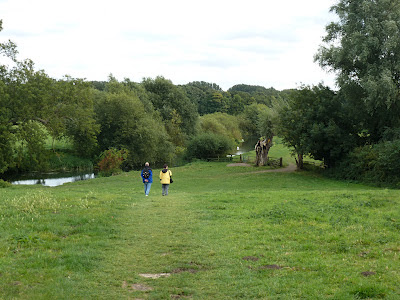Explorations Of Village Footpaths (part the second)
If you haven't read yesterday's post then you really should; otherwise you won't have a clue what I'm talking about!
We'll set out first on a little side road called the Bridle Way. That's exactly what it is nowadays, a route open to horse-riders, but also to walkers and cyclists. At this end, as you can see above, it's also open to cars though it only leads to a handful of houses that have been built alongside. But it was once the road which led from Grantchester to the neighbouring village of Barton. After the Enclosure Acts it was decided not to maintain this track as a proper road. But the right of way was preserved as a bridleway.
While we're here it's worth peering into some of the little paddocks where horses graze. For here is evidence of the old medieval field pattern in the form of ridges and furrows. As the land was ploughed, year after year, the soil became heaped up towards the centre of the strips to form parallel ridges. If you look at the base of the hedge behind the pony you can make out the gentle undulations which are preserved to this day.
Now a medieval horse- or ox-drawn plough is a long and cumbersome piece of equipment which can't be easily turned at the end of each strip; the ploughman had to steer out and then cut in to get the plough around. This practice caused the strips to take on a slightly curved, reverse-S shape. Look at the photo above - the shape of the edge of the old strips has been maintained by the farm track. The strips actually ended in front of the wooden shed; you can just make out a grassy slope where a track used to run at the edge of the old open field system.
When the fields were enclosed at the beginning of the nineteenth century a new road was planned to run towards Coton. That's it above - can you see the gentle undulations in the road surface as it crosses the old ridge and furrow of the open field? Well, I did warn you that these clues were subtle!
Nearby is another track between fields which isn't a right of way at all though many people treat it as if it were. It's called "The Baulk", as in the title of this post. The name gives away its origin for a baulk was simply the path that existed to give access to the strips in the open fields.
Sometimes these curving baulks have been straightened by modern farming. In the picture above you can just make out a raised hump where the baulk swung off towards the right.
The path I've just shown you forms a sort of crossroads with a modern-looking farm road. It comes from nearby Barton with a directness which seems to indicate that it's heading somewhere important. Yes, I know I said that the Bridle Way was the road from Barton, well this is another one! The economics of road maintenance has changed somewhat. Nowadays it would be wasteful to have two roads running parallel to one another but in the past when little was spent on the upkeep of roads it was handy to have two tracks; if one became muddy and impassable you simply swapped to the other! Now, where is that track heading?
The concrete road comes to an end but behind the hay-cutte another path continues on the same line. It dives between two thick hedges.
A little further along the village road maintains the same line.
And then it passes through a gap between walls. Modern gardens have encroached on the old road from either side but the right of way is preserved by law so they can't pinch all the land! And where is this track leading us?
To the Millpool, that's where. The route we've been tracing was the old waggon road which brought corn to be ground at the water-powered mill. At some time there must have been a waggoner sitting atop his cart whistling away and little realising that he was on the last waggon that would ever pass this way.
Oh, yes. "Baulk And Grind". I've still got some explaining to do. The "grind" is "The Grantchester Grind", the footpath that runs from Cambridge through picturesque meadows to Grantchester. It's much favoured by students and tourists - few of whom incidentally notice that they are walking through a well-preserved medieval field system - but that's not who caused the path to be there originally. Newnham, which is now part of Cambridge, was once part of the parish of Grantchester and people would have walked along the path to attend church; it heads straight for the church, in fact.
And many people must stop to gaze down towards the river at this point. And many wander down to the riverbank. But do they realise that they are walking down a path whose original duty was to bear carts carrying milk-churns down to the river where they were stood in the shallows to keep cool till they could be transported down to Cambridge by boat?
Take care.
















































